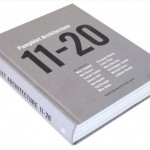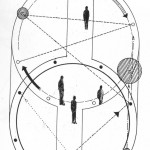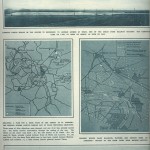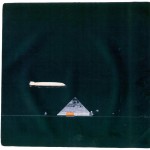Mikhail Okhitovich was a singular figure in Soviet architecture of the 20’s and 30’s. As a Bolshevik sociologist, town planner and Constructivist architecture theorist he expressed his positions as a member of the OSA Group and by writing on the Osa bulletin Sovremennaia Arkhitektura. As a supporter of the Left Opposition of Leon Trotsky, he was naturally at odds with the Communist Party during Stalin’s leadership and, after attacking the cult of personality, he was first reprimended by the Politburo for his intellectual and architectural production (under the accusation that the theory he fostered, Disurbanism, was potentially economically crippling), then arrested, sent to the Gulag and eventually shot to death in 1937.
He was the original developer of the theory of Disurbanism, to be rejoined at a later stage by Moisei Ginzburg, (after, according to the legend, he sequestered him inside an office and convinced to abandon LeCorbu’s ideas of urbanization), producing a shift in the Osa, (OSA architects were employed by the state to develop a standard for apartment buildings (the Stroikom apartments) for the purposes of mass production), while the group was probably already shaken by the brutalities of forced collectivisation in the Soviet countryside.

Note by Mikhail Okhitovich
The radical theory fostered an abolition of the traditional concept of the town, adopting a plan of settlements dispersed across the territory of Soviet Union, with communal dining, recreational amenities and employment centers at road junctions, – vaguely remembering Frank Lloyd Wright‘s Broadacre City.
Through a trasportation, energy and communication grid crossing the nation, clusters of glass cubicles and mobile homes, the Disubanist would have scattered single family houses across the countryside. They sought to eliminate urban agglomeration in central cities and create new, self-sufficient settlements containing fewer than 50, 20, or even three residents.

Public-House for 100 People (1930)

Public-housing for 500 Individuals
The disurbanist vision was in fact extremely concrete, given the possibility of inmediate experimentation in creativily burgeoning and rapidly technologically advancing early Soviet Union: in Ginzburg’s Green City Plan (1930), the state would grant each person a prefabricated lightweight house, letting him free to combine and arrange the modules, from the single unit to the family or community clusters, using highways, rails, automobile and airplanes to strung them. In Constructivist poet Velimir Khlebnikov and writer Nicoli Aseev, the Disurbanist vision was accompanied by stories of mobile agglomerating glass boxes or entire mobile cities floating across the countryside with the aid of a magnetic levitation. Moscow, liberated by the need of massive urbanization was to be converted into a park.

Moses Ginzburg’s prefabricated housing units
Okhitovich, Ginzburg, Zelenko and Pasternak (Boris’ brother) plan for Magnitogorsk (1930) was the epitome of Disurbanism rejection for the conventional centralized city as a capitalist social formation. Instead of large collectivist dwellings they sought for the development of individual personality under socialism. Okhitovich wrote that ‘the stronger the collective links, the stronger the individual personality’.

Ribbon-city proposal for Magnitogorsk (1930)
Their modular “pods” (individual housing units) were freely associable or dismantled according to the individual personality and the evolution of his familiar bounds. The physical “link” between one or more pods equalled to an affective link between couples of people. A birth could be accomodated with more pods, while separations didn’t have the disadvantages of space and property since a divorced couple could simply go separate ways by uncoupling pod-houses. Of course questioning of the familiar bonds would help dissolving them, forecasting other kinds of societal institutions. Children, for example could have been cared for by specific established apparatuses and once reached the age of maturity, they would have been granted the right to dissociate themselves from the rest of the natural family.

“Pod”-houses proposed for Magnitogorsk
Alexander Pasternak wrote that the fixed house was an ‘anachronism, apathetic and out of place, no longer an active participant in an active and fast moving life’

“Pod”-Houses for Magnitogorsk (1930)
Thanks to Léa-Catherine Szacka for suggesting us to research this fascinating topic and Qqueegueg for linking to the epistolary exchange between Le Corbusier and Ginzburg (see below).
References:
“Delirious Moscow” (In Search of Lost Vanguards – Excavation and Space Exploration in Constructivist Architecture ), John Jourden
“Post Soviet Social – Neo Liberalism, Social Modernity, Biopolitics“. Stephen J.Collier
“The ideal Soviet Suburb“, Social Change Through Urban Design – UPenn, by WM. Stephen Scott
“Terror in Soviet Architecture: The murder of Mikhail Okhitovic“, Hugh D.Hudson Jr.
“Why was disurbanism not successful?“, Amrit Seta
Frampton, Kenneth (2004) (Paperback). Modern architecture — a critical history (Third edition ed.). World of Art. p. 376 pages. ISBN 0-500-20257-5.
“Militant Modernism” – Owen Hatherley
Macel, O (1989). “Tradition, Innovation and Politics”. In Kloos, M.. Soviet Architecture. Amsterdam: Art Unlimited Books. pp. 18.
French, R (1995). Plans, pragmatism and people: The legacy of Soviet planning for today’s cities. London: UCL Press. pp. 29.
Hugh D. Hudson, Jr. Terror in Soviet Architecture: The Murder of Mikhail Okhitovich Slavic Review Vol. 51, No. 3 (Autumn, 1992), pp. 448–467
Cooke, Catherine, (et al) (1990). Architectural Drawings of the Russian Avant-Garde. [Online Image] Available from: http://en.wikipedia.org/wiki/File:Ladovsky_sketch.jpg [Accessed 10/03/2012]
РАСПАД города» (Бруно Таут)/“The DISINTEGRATION of the City”/Die Auflösung der Städte (Bruno Taut), by Ross Wolfe
While all the merit goes to Ross Wolfe (I decidedly recommend to read his work at the Charnel House and Modernist Architecture) for gathering together (translating, too?) a lot of original textes by Okhitovich, Ginzburg and other, I decided to copy them here for the sake of archival record and historical diffusion.
Mikhail Okhitovich, “On the Problem of the City” (1929)
From Sovremennaia arkhitektura 1929 (no. 4, pgs. 130-134)
It is necessary to reassess the nature of the possible in accordance with the requirements of the epoch.
Under present conditions, with public servicing and utilities whose cost is proportional to the width of the plot, the dwelling has had to be built upwards and backwards, and it must be constructed of strong and durable materials on solid foundations.
Does it emerge that the crowded town is the inevitable result of the technical and economic possibilities? Does it emerge that all other solutions to the problem are technically or economically impossible?
The city is a specific socially, not territorially, determing human reality…It is an economic and cultural complex.
The question to be elucidated is now, must the different functions of the ‘city’ exist in one body; will they become fatally estranged by separation, as the parts of a living organism would be? In other words, is the growth of huge crowding, including ‘socialist’ crowding, of people, buildings, and so forth on one spot inevitable, or not?
The planning of an industrial enterprise can now reflect the possibilities of conveyor belt production on the scale of the whole national economy, and eventually of the whole world economy.
The exceptional growth in the strength, quality, quantity, and speed of the means of mechanical transport now permits separation from centers: space is here measured by time. And this time is itself beginning to be shortened.
The revolution in transportation, the automobilization of the territory, reverses all the usual arguments about the inevitability of congestion and the crowding together of buildings and apartments.
We ask ourselves, where will we resettle all the urban population and enterprises? Answer: not according to the principle of crowding, but according to the principle of maximum freedom, ease and speed of communications possibilities.
All these linked functions make up a single organizational complex. But the city was also a complex. Having destroyed one form of the city, will we not be creating a new city? If you like a quarrel about terminology, let this complex be a city.
Let us call it, shall we say, the Red city of the planet of communism.
If one talks about the essence, then this new complex will be called not a point, a place, or a city, but a process, and this process will be called disurbanization.
Disurbanization is the process of centrifugal force and repulsion. It is based on just such a centrifugal tendency in technology…which reverses all former assumptions. Proximity is here a function of distance; community is now a function of separateness.
The conversion of Moisei Ginzburg (Soviet delegate to the CIAM from 1928 to 1932) to Disurbanism let Le Corbusier in a state of dismay. Here’s the letter the Swiss sent to the Soviet collegue:
Moscow, March 17, 1930
My dear [Moisei] Ginzburg,
I am leaving Moscow this evening. I have been asked to write a report on the recent competition for the Green Town of Moscow. I haven’t done so, not wanting to present a judgment on the work of colleagues. On the other hand, I answered the request that was made to me indirectly, by giving the Committee for a Green Town ‘some commentaries on the development of Moscow and the Green Town.’ My conclusions cannot agree with the enthusiasm that the simple word ‘deurbanization’ seems to raise at the moment.
There is a contradiction in the term itself; this word is a fundamental misunderstanding that has deceived many Western theoreticians and wasted a lot of the time of governing boards of industries — a fundamental misunderstanding that everything opposes and refutes. Society is complex; it is not simple. Whoever tries to bring hurried and tendentious solutions to its problems will [265] meet opposition: it revenges itself, it falls into a state of crisis, and despite changes and regulations, it doesn’t let itself be manipulated: it is life that decides!
Last evening, in the Kremlin, in the office of Mr. Lejawa, the vice-president of the USSR, Mr. Miliutin, one of the commissars of the people, had a thought of Lenin translated for me that, far from supporting the thesis of deurbanization, on the contrary confirms the necessity of urban reform. Lenin said this: ‘If one wants to save the peasant, one must take industry to the country. Lenin did not say ‘If one wants to save the town-dweller’; one mustn’t confound, there is all the difference! To take industry to the country, that is to say industrialize the country, that is to create places of human concentration with machines at their disposal. The machine will make the muzhik think. Nature is good for the city-dweller whose mind has been galvanized by the city, who puts to work, in the city, the diligent mechanism of his mind. It is in the group, in shock and cooperation, struggle and mutual help, in activity, that the mind ripens and brings forth fruits. One should like to think so, but reality is there; it is not the peasant who looks at the trees in bloom and listens to the song of the lark. It is the town-dweller who does that. You understand what I mean, if, frankly, we are not fooling ourselves with words.
Men feel the need to get together — always, in all countries and climates. The group brings them security and defense, the pleasure of company. But as soon as climates become difficult, grouping encourages industrial activity, production by means of which men live (are dressed, make themselves comfortable). And intellectual production is the daughter of united men. Intelligence develops, is sharpened, multiplies its play, acquires its subtlety and innumerable aspects, in the mass of groups. It is the very fruit of concentration. Dispersion frightens, makes poorer, and loosens all the ties of physical and spiritual discipline, lacking which men return to their primitive state.
International statistics show us that death rates are lowest in the densest agglomerations; they diminish as populations concentrate. These are statistical facts; they must be accepted.
History shows the great movements of human thought at the mathematical points of greatest concentration. Under Pericles, Athens was closely peopled like one of our modern cities, and that is why Socrates and Plato were able to discuss pure ideas there.
Consider more exactly that ten centuries of premachine civilization have made these cities for us which at the moment of mechanical expansion are a frightful and dangerous grimace. Admit then that the evil is there, in that heritage, and that its salvation is here: to adapt the cities, which will continue to concentrate themselves more and more (statistics and concomitant elements [266] of modern progress: transports: intellectual attractions, industrial organization); to adapt our cities to contemporary. needs, that is to say to rebuild them (as, besides, from their birth they have continually rebuilt themselves).
My dear Ginzburg, modern architecture has precisely the magnificent mission of organizing the life of collectivities. I was the first to proclaim that the modern city should be an immense park, a green city. But to allow this seeming luxury, I increased the density by four and — instead of extending them — shortened distances.
I can nevertheless imagine very well, as a satellite to any urban agglomeration for working and living, a Green Town for resting, eventually organized as with you by turns every fifth day.
I even pointed out in my comments that the compulsory attendance for rest, at least once in three periods, every fifteen days, could be applied like time-clocking for work: and would include the practice of an adequate sport by individual prescription of the doctors of the Green Town. The Green Town becomes the garage where the car is checked (oil, lubrication, verification of organs, revision, maintenance of the car). Besides, the intimacy with nature (radiant springs, winter tempests) incites to meditation, to introspection.
Please then do not see a hostile attitude in my serene and firm affirmation: ‘Mankind tends to urbanize.’
Appreciate this characteristic detail yourself — one of the projects of deurbanization proposes, among other things, to build straw huts in the forest of the Green Town. Bravo, magnificent! as long as they are only for weekends! But do not say that having built huts in straw, you can then tear down Moscow.
Very cordially yours,
L.C.
To which Ginzburg answered:
My dear Le Corbusier,
Our recent conversation about city planning and your letter have compelled me to rethink the entire problem, to recall your objections, the objections you made when you visited me and which you now write about in your letter.
Like all my friends, I value you tremendously not only as a subtle master architect but also as a man with the ability to solve radically and fundamentally the important problems of organization.
For me you are today the greatest and most brilliant representative of the profession that gives my life content, goal, and meaning.
That is why your ideas and solutions in the area of city planning have for us a quite exceptional interest and importance.
You have often told me that you adore nature and would like to live always among greenery…You write that you were the first to advocate the luxury of an enormous park in the city…During our stroll on Tverskaia Street [the present Gorkii Street] you told me that Perret and all the best of the French architects had tried to take housing out of the city. In other words, you yourself pose the problem of giving man ideal physical surroundings, a problem for which we are trying, in our projects, to find a radical solution. But you feel obliged to consider such a radical solution possible. In other words, in spite of your brilliant gifts, you find yourself powerless to overcome the objective contradictions of modern capitalism.
A careful study of your work shows that it is in fact a consistent and stubborn attempt to round off the sharper corners of city planning and smooth and soften all its rough edges.
You are the finest of the surgeons of the modern city, you want to cure it of its ills whatever the cost. Therefore you raise the entire city on stilts, hoping to solve the insoluble urban traffic problem. You create wonderful gardens on the roofs of tall buildings, hoping to give people an extra patch of green, you design homes whose occupants enjoy perfect convenience, peace, and comfort. But you do all this because you want to cure the city, because you are trying to keep it essentially the same as capitalism made it.
We in the USSR are in a more favorable position — we are not tied by the past.
History confronts us with problems that can only have a revolutionary solution [paraphrasing Marx] and, however feeble our resources, we will solve them no matter what.
We are making a diagnosis of the modern city. We say: yes, it is sick, mortally sick. But we do not want to cure it. We prefer to destroy it and intend to begin work on a new form of human settlement that will be free of internal contradictions and might be called socialist. We know that raising a city on stilts (and you have seen that in this respect we are following your example) does not permit a radical solution of the urban traffic problem. Driving between columns is almost the same as driving through narrow streets.
We know that the roof garden is an excellent architectural solution, but it cannot solve the sanitation problem, the problem of open spaces. And similarly, we would like to find a solution for the living unit, but not in the form of a luxurious private home or a European-type hotel.
You yourself talk of international statistics which show that the birth rate is the highest and the death rate the lowest in the most densely populated areas. But this is only natural. The thinly populated centers are poor villages and without doctors or culture, without means and without decent food. You write that culture develops only where people are concentrated in large masses. But this is perfectly understandable. It describes the situation in a capitalist society, though not elsewhere. We in the Soviet Union must make culture available to the entire population, not merely the urban population, whatever the cost. But to do so we cannot transfer 100 million of our peasants to the big cities, not without destroying our agriculture. Accordingly, we want all the beneficial consequences of concentration for the development of culture and, at the same time, all the advantages of dispersal and decentralization for spreading culture as uniformly as possible over the population. And for this it is necessary to create new socialist forms of population settlement based on elimination of all the disparities between town and country.
You are absolutely right in your high evaluation of the collective in human history. But our disagreement is not along those lines. The higher requirements of collectivism and industrial concentration demand decentralization and dispersal in space; that is the crux of the matter.
I note with pleasure that you consider it necessary to quote Lenin. You say that he thought of saving the peasant by introducing industry into the village, but did not think at all of saving the city dweller.
But you are wrong, my dear Le Corbusier. Not only about Lenin but Engels and Marx thought long and often about both. Or rather for them these were two aspects of the same problem.
Permit me to quote their own words on the subject:
A resettlement of mankind is necessary, with the elimination of rural neglect and isolation and the unnatural crowding of huge masses into the big cities.
– Lenin
The separation of town and country has condemned the rural population to millennia of backwardness and the urban population to being mere wage slaves, it has destroyed the basis for the spiritual development of the former and the physical development of the latter.
– Engels
The contradiction between town and country is the coarsest expression of the subjection of the personality to the division of labor, which transforms the individual into a limited urban animal, on the one hand, and a limited rural animal, on the other.
– Marx
You refer to Perret’s unsuccessful attempts to take housing out of the city. But this too is quite understandable. He severed an isolated member from a complex organism. That member inevitably wasted away. We are removing from the city nothing less than the city itself, its entire system of supply and culture. In other words, we are creating a whole new organism. This is quite different from what Perret was trying to do.
You write that the peasant does not love flowers and does not hear the song of the skylark. But of course he doesn’t…when he is exhausted with backbreaking labor. But we want our peasant to listen to the skylark. And we know that for this it is only necessary to lighten his labor and bring more culture into his life. And all this will be possible not by smoothing out the contradictions with which the modern capitalist system is riddled, but by creating new forms of human settlement more worthy of the future.
We are aware that we have yet to find the solution to this very difficult problem. But we cannot refrain from posing it, we cannot refrain from trying to solve it. That is our duty, the duty of architects who would like to become the architects of socialism.
Moreover, we hope that in the future, as in the past, we shall be able to learn a great deal from you, and that what we learn will help us to solve our new and difficult problems.
Cordial greetings from myself and my friends,
Yours sincerely,
M. Ginzburg
From Sovremennaia Arkhitektura, 1930.
Years later, Le Corbusier compiled his criticism on Disurbanism in his book, The Radiant City (1930-1933):
In Moscow in 1930 the fad of the moment was for ‘deurbanization.’
‘The murderous stone-cannon of the city, the stifling, the crushing of the city dweller is a purely capitalistic manifestation.’
Therefore the city must be smashed into ten thousand pieces and scattered across the countryside, in the woods, in the meadows, so that the houses will be in the heart of nature itself. Thus, man will have returned to the first wellspring of his inner harmony.
‘All well and good,’ I replied. ‘But what about the work of the city (for the question of rural exploitation is in no way involved here), the work that must be accomplished within the 24-hour daily solar cycle?’
Their answer was that they would build whatever roads were necessary to link all their scattered houses to the city center. Everyone would have a car. They were going to manufacture however many cars, however many roads proved necessary…
But to return to the U.S.S.R. Plans were drawn up, propaganda films were screened for the benefit of committees. People were encouraged to entertain an idle dream: ‘The cities will be part of the country; I shall live 30 miles away from my office under a pine tree; my secretary will live 30 miles away from it too, in the other direction, under another pine tree. We shall both have our own car. We shall use up tires, wear out road surfaces and gears, consume oil and gasoline. All of which will necessitate a great deal of work; there will be a titanic demand for labor; enough for all: no threat of unemployment looming in the future, never again’…
Then one fine day, authority, which is the door of reason against which all dreams, just and chimerical ones alike, must eventually knock, authority in the U.S.S.R. said: ‘Enough! It’s all over! And stop that laughing!’
The mystic belief in deurbanization had fallen flat on its face! Pg. 74.
and:
A friend of mine from Moscow [Ginzburg], a technician whose job it is to solve a variety of Soviet city-planning problems, objected to my plans for the Radiant City when they were exhibited in our studio because they do not comply with present Soviet theory…Such is the doctrine of ‘deurbanization’ that is all the rage in the USSR at this moment [1930]. Pg. 135.
But let us go back to the U.S.S.R., to revolutionary Russia, which in this sphere, through a disastrous confusion of aims that will not — I am certain of it — fail to be defeated eventually by the foresight of Soviet organizers, is at this moment embracing the most decadent of all the theses evolved by our Western academic committees. For the U.S.S.R. is also intent on dismantling its great cities, just as our own city authorities are all dreaming of sending us out into the fields (their garden-cities) to scrabble earth around a lot of hypothetical onions and live out Jean-Jacques’ eighteenth century fantasy (and without his wit). Pg. 136.
The Russians, intent upon their present negation of the city, have coined the term ‘transplantation’ to deal with these people. They are attempting to turn these masses of urban flotsam into colonial settlers. They expect these parasites to become pioneers. Pg. 138.
Nikolai Dokuchaev, the Rationalist avant-garde architect, was not pleased with this solution either. He authored an article in 1930 on “The competition for the planning of Magnitogorsk” in Stroitel’stvo Moskvy, 1930 (no. 4/April, pg. 28):
The ‘linear planning’ projects by the OSA group and Stroikom (whose authors are also OSA members), are a repetition of the well known idea of linear distribution of a town along the communication routes, with houses of an individual or semi-individual type (as in the OSA project here, under team-leader I. Leonidov). The OSA group as a whole has recently been advancing this idea of Disurbanization at every appropriate opportunity. Its underlying principles and arguments, at least as presented by comrade Okhitovich, are familiar to the majority of our specialists. In the Stroikom project, the authors have again tried in their explanatory notes to prove by all possible means that the ‘industrial’ pastorale which they propose in the form of direct communion with nature, little houses on stilts for each individual, with a car underneath it awaiting the owner, constitutes a socialist town. The individual houses with private motor cars are the authors’ answer to the Leninist concept that it is necessary to create ‘a new form of human settlement which eliminates rural backwardness and isolation from the world, and the anti-human concentration of vast masses of people into large cities.’ And here we are: the little cottage cuts itself off from the urban concentrations; the motor car abolishes the rural isolation. A solution of true ‘genius’ for this problem!
The OSA project also offers small two-storey houses, these designed for sixteen people, lightweight in construction, heated by stoves, and with the area of service space larger than that of the living area. These too are ‘high convenience’ housing, favoring the development of individualistic habits and private acquisitiveness. Combining housing of this type into a skyscraper does not alter its organization in the very least. The chosen system of distributing the houses and communal buildings within the town is principally dictated by the desire for certain graphic effects on the drawing and the base-board of the model, rather than by considerations of convenience and rationality, about which the authors speak so confidently in their explanatory notes. Where should one search here for the ‘new organization of labor, life-style and culture, etc.’ which are ostensibly present in this project ‘based on the new social structure, advanced science and technology and the most economic utilization of available resources’? By what means is this ‘new social structure,’ which is not visible to the ‘uninitiated’ viewer, expressed in the design of the city? Why, in the fortuitous and chaotic distribution of the housing and communal buildings, which is interesting only as a picture, should we be supposed to see a novel solution to the socialist town, rather than just another colony of some self-build dacha association. Apparently the answer lies in some public debate, but not in working up a practical project. In these situations we have the right to demand such things as a serious attitude, and some detailed practical solutions for the problems posed and executed by these architectural societies.





Great post! Thanks for the kind mention.
thank you for your great work! f
Great website. Plenty of useful information here.
I’m sending it to several buddies ans additionally sharing in delicious. And obviously, thanks to your effort!